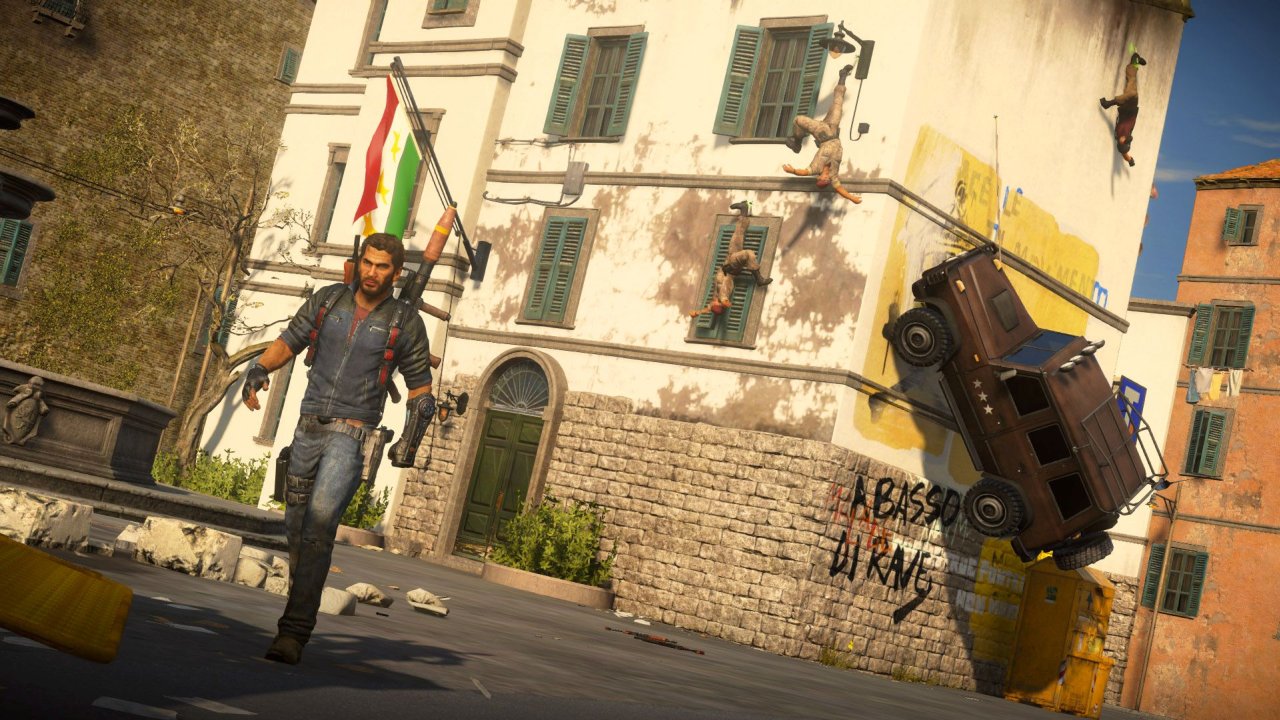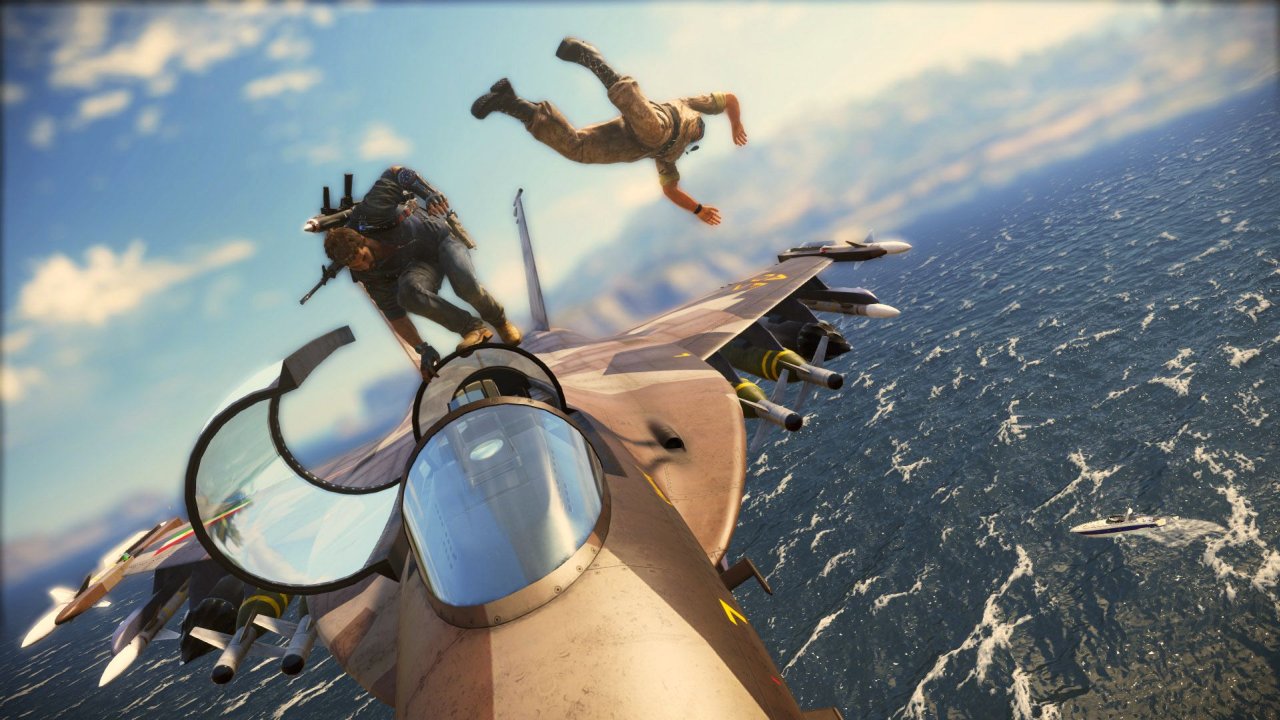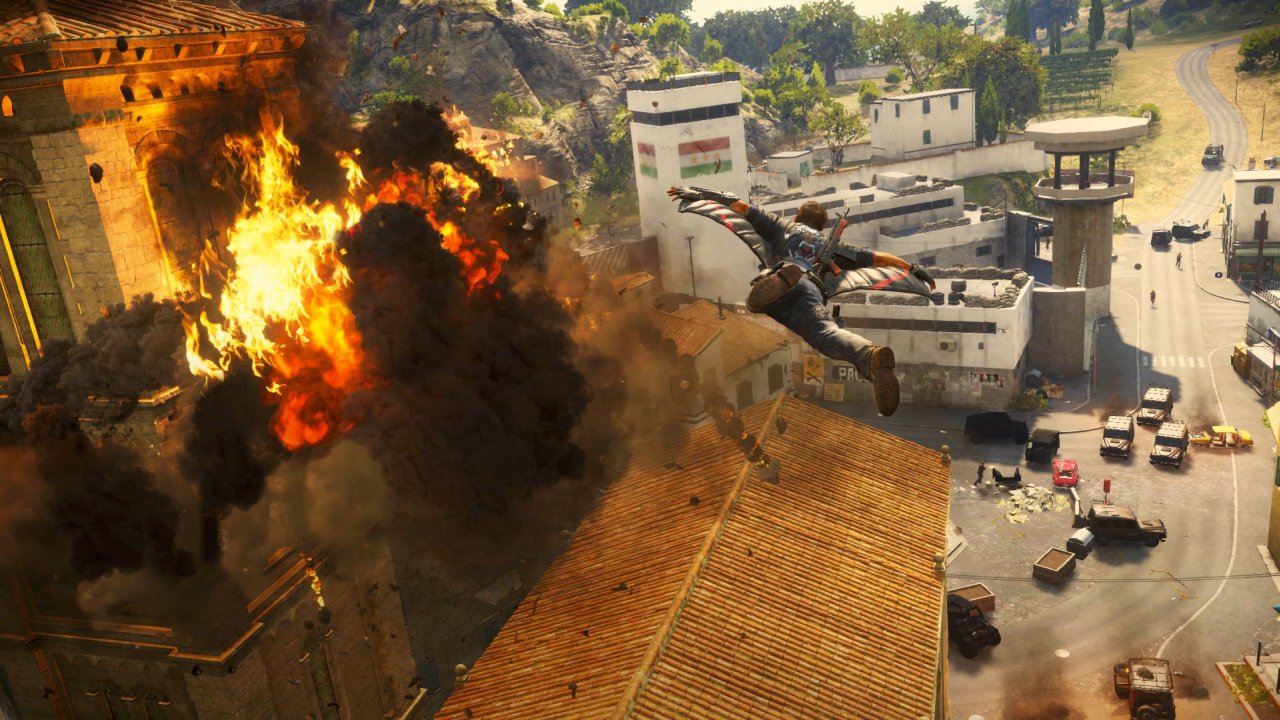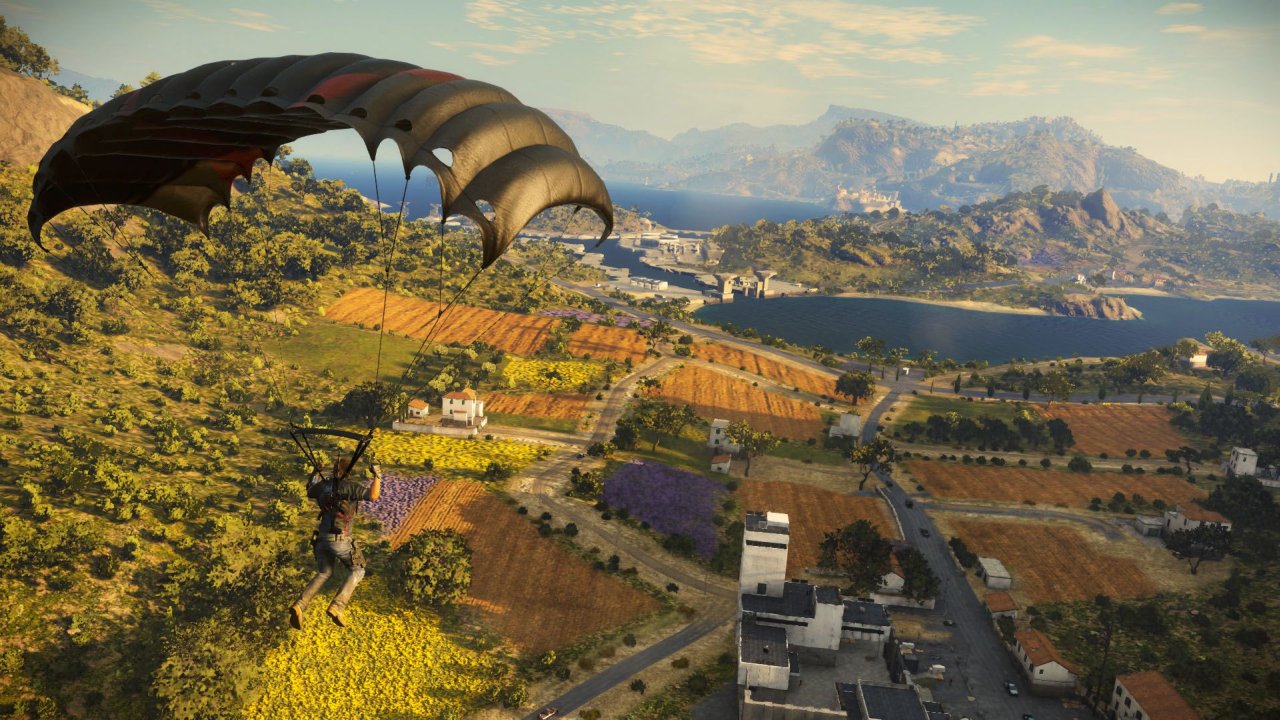Just Cause 3 Review
Let it never be said that games have to be particularly smart to be fun. By all means, make appropriately awed noises when a game’s systems interlock beautifully, or when a game’s writing pushes the boundaries of the medium, or when a game is stuffed with mechanical subtleties that elevate it above its outward appearance, but there’s always a time – usually after a lousy day full of incompetence and late buses – when it just feels good to switch off and play something really stupid. Mindless gratification done right can be as memorable and engaging as anything else, whether it’s driving headlong into an intersection in Burnout 3 or slaughtering a thousand screaming headless men in Serious Sam, and no game did this better than Just Cause 2. It was, if I can get a bit vague for a moment, the right kind of stupid; a simple formula made brilliant by the amount of thought that went into ensuring that the destruction was satisfying, the conditions for destruction were perfect, and the means of causing destruction were as over-the-top as they were versatile. As a pretty clear iteration on that formula, Just Cause 3 makes a lot of improvements on its predecessor, but makes a few crucial changes that severely damage its potential for sustained chaos.

So here we are in the Mediterranean paradise of Medici, a considerable step-up from the not-Mediterranean paradise of Just Cause 2’s Panau, if only because it looks like a genuinely attractive holiday destination that isn’t mostly impenetrable rainforest. As per usual, it’s been taken over by an oppressive dictator who wipes his bum with the Universal Declaration of Human Rights and treats his citizens with the level of respect I normally reserve for the people who phone me up purporting to be from “Windows support”, so Rico Rodriguez is here to do what he does best: destroy massive amounts of crucial infrastructure and kill thousands of people to solve a minor political dispute. You know the idiom “cut off the head and the snake stops moving”? When did that become “plant explosive charges all over the snake and hope that the head comes out from whatever rock it’s hiding under”?
Never mind. If I start questioning things like that, I might never stop. The intro sees Rico and his preposterously American colleague flying into Medici for reasons that aren’t made exactly clear, but after being forced to stride back and forth across a Cessna’s wingspan firing rockets at anti-air turrets, he develops an understandable dislike of the local big baddie – a sausage-fingered fellow called General Di Ravello – and takes up arms with the resistance. From there onwards, the overarching goals of the game are more or less taken as read: help the resistance forces take back the land, destroy anything that the military considers valuable enough to give a fresh coat of paint, and of course, push the good General into an active volcano.
So there I was, recently spat out by the tangle of tutorials and awkward character development into the world, and was able to finally appreciate the ways in which this sequel had streamlined a formula that I, in 2010, had believed to be nigh-perfect. The thing that made causing chaos in Just Cause 2 so satisfying – apart from overloading on cathartic overblown destruction – was that it tempered the mindless destruction with a certain amount of creative potential, letting you stick explosive charges in unusual places and tie all kinds of things together with the grappling hook. A pity, then, that Rico could only carry as many explosive charges as he could fit in his back pocket, and that the grappling hook had the tensile strength of dental floss, limiting what you could realistically do somewhat. Just Cause 3’s tools give you considerably more opportunities to set up destructive performance pieces, giving you access to a bottomless supply of explosive charges, tiny rocket thrusters that can be affixed to any surface, and numerous pieces of civil infrastructure carefully engineered to collapse in complex ways if you target them just right. Sounds overpowered, and perhaps it is a little bit at times, but there’s enough adversity left in the island’s occupying forces to stop the game feeling like an endless line-up of sun-kissed sandcastles to aimlessly kick over. If anything, thanks to the prevalence of tanks able to lead their shots like Tribes-addicted physics majors, it’s even tougher than its older brother.

And then there’s the upgraded grappling hook, which is quite possibly the most fun I’ve had with a physics toy since Garry’s Mod gave me the power to put ragdolls in compromising positions and then crush them all with shipping containers. Not only is Just Cause 3’s grappling hook capable of retracting at will – letting you drag props around without tying them to a forklift or something – but with the right upgrades it becomes frightfully strong and capable of supporting multiple tethers at once, both of which were only possible in Just Cause 2 if you liked installing dodgy mods that crashed every five minutes. Finding new and inventive ways to utilize the grappling hook comprised the bulk of my favourite moments with this game; not just in terms of its destructive potential, but just in terms of seeing how the world reacts when you start toying around with it.
Tying a helicopter to the ground and watching it spiral out of control almost immediately is enough to earn a smile, but it’s nothing compared to suspending a helicopter between two spires and watching it hopelessly struggle like a fly in a Kevlar web. Watching radio towers collapse into neat little piles of pieces is alright, if you’re still impressed by rigid body Havok physics for some reason, but it’s far more entertaining to pull one over in such a way that it rains debris all over the firefight you’re currently engaged in. Your new tools feel full of potential, and much like its predecessor, the game does you a service by having little to no guidance (outside of the obligatory tutorials) on how to apply them to the world around you. It’s up to you to discover their uses and decide on how they’re best utilised, creating an experience that manages to be both destructive and weirdly creative.
Unfortunately, most of them aren’t going to be working at full capacity until you’ve tussled with the progression system, which takes the elegance of Just Cause 2’s chaos system and feeds it through a rusty mincer. Just Cause 3, in comparison to its more anarchic predecessor, is evidently trying to shed some of its uncomfortable “wait, isn’t this just government-sponsored terrorism?” exterior by having you consciously “liberate” areas – including towns and bases – rather than just speeding through them shooting at anything painted red. Liberated areas are automatically taken over by resistance forces, and while it is a little cheering to feel as if you’re having a tangible effect by slowly creating more and more areas free of Di Ravello’s control – complete with citizens who are confusingly eager to egg on the mysterious agent who just blew up half their town – as a system of progression it turns the business of causing chaos from a carefree romp into a completionist slog.

Let me explain. Equipment upgrades are unlocked by doing activities – racing, going on rampages, driving things really fast into other things – and activities, along with story missions, are unlocked by liberating areas, so if you want to play with all Just Cause 3’s best toys then you’re going to want to free as many places as possible. The problem is that in order to liberate an area – and hence, make any kind of practical progress – you’ll need to hunt down and destroy every last piece of government property in the area: every fuel tank, every propaganda tower, every statue, every billboard, everything. You even get a bloody checklist on your HUD showing everything still requiring your attention, like you’ve just been instructed to find twelve sewer rat skins and kill five gnolls. Some of the tasks you get lumped with don’t even come with the promise of satisfying destruction, but just ask you to carry out busywork like turning off monitors or raising a flag in the town square.
Just Cause 2’s chaos system might’ve been difficult to explain in the context of the plot at times – how exactly did making more things explode grant me the right to use a helicopter, anyway? – but what was admirable was that it was so inherently freeform: anything that generated chaos, from completing side-missions to shooting a single oil drum, would put you a little closer to the next unlock, so you were free to carve a merry swathe of destruction through the world without having to stop and carefully make sure that you hadn’t left something intact somewhere along the way. Even just casually hosing down a military base with helicopter minigun fire on the way to somewhere more important would give a small measure of progress. Just Cause 3’s system turns destruction into a chore, like pruning a hydrangea that occasionally sends swarms of aggravated but ultimately ineffectual bees after you. It hardly seems fair to call it ‘chaos’ anymore – though the game still keeps a tally of your total chaos for some baffling arcane reason – when you’re practically rewarded for being as methodical as a data entry clerk.
It’s a pity, because while the game’s systems feel as if they’re actively impeding the spectacular opportunistic rampages that make Just Cause such a singularly brilliant way to unwind, the environments have clearly had a lot of thought put into supporting those very spectacles. Just Cause 2’s Panau got a lot of approving noises at the time of its release for being roughly large enough to swallow Liberty City several times over, but the sense of awe-inspiring scale lost most of its impact once you realised that ninety percent of the map was dusty rickshaw-choked carriageways and nondescript undeveloped land. I haven’t broken out the ruler just yet to see how Medici measures up – because honestly, who gives a damn? – but at any rate it feels like a better use of space; more condensed, and more conducive to the game’s action-movie shenanigans. Between the winding cliffside roads, crumbling hilltop ruins and towering weblike fortresses, it feels like there’s been more careful attention paid to incorporating verticality, granting plenty of organic opportunities to grapple your way around and drive cars off things they probably shouldn’t be driven off of. Significant settlements feel more reasonably spaced, and the ground in between – while not nearly as varied as Just Cause 2’s smorgasbord of biomes – tends to be more rolling meadows than impenetrable forest, which is something of a boon when you end up standing on top of a bus as it careens off the road into somebody’s field.

And you may find yourself careening off the road a little more than you’d intended, because Just Cause 3’s vehicle physics are… a little bit strange, actually. You could say the same about the physics of the game as a whole – I failed one mission multiple times because the vehicles I was supposed to protect were regularly catapulted several miles into the bay by nearby explosions – but driving in particular feels like a not-quite-successful attempt to integrate more arcade-y driving mechanics into a world where they simply aren’t welcome. Everything turns with absurd responsiveness on superheated tyres that perfectly cling to the road, letting you cruise around with the least interesting handling possible right up until the point you pass some arbitrary grip threshold. Then the physics engine looks over at what you’re doing, gets all excited at the opportunity to show off, and promptly leaps in to send you into an uncontrollable tailslide. Maybe some people prefer it like this, and my revulsion is just due to my abhorrent personal taste – I’m one of those weird types who kind of liked the driving in Grand Theft Auto IV, because I enjoy grappling with tiresome forces like inertia and friction and lousy rush-hour traffic – but no such excuse exists for the helicopters, which sway around like marionettes with drunken puppeteers every time you go anywhere near the controls. I spent most of my time travelling by grappling hook, but let’s be fair: between the bonkers physics, infinite supply of parachutes and new steerable wingsuit, it’s tough to come up with a finer way to commute. You can swoop and soar and swan-dive for miles without ever touching the ground.
After you’ve gotten stuck into the story missions, ‘commute’ really does start to feel like the right word, though. I’ll readily admit that complaining about the writing in a Just Cause game is like bringing a hairdryer to the dinner table to warm up your gazpacho soup, but once again, it’s important to remember that there are different kinds of stupid. Just Cause 2’s story was an abominable paranoid trainwreck full of cardboard-cutout characters and voice acting that belonged in a budget Resident Evil knock-off, but all that gave it a certain lovable B-movie charm, isolating anybody experiencing it in a thick hazmat suit of irony. Just Cause 3 tries a lot harder to achieve a legitimately competent narrative amid all the mayhem, and it really just comes off as awkward. Yes, characters now sound and act like actual human beings instead of bizarre mannequin demons, but that just makes it all the more disconcerting when the game tries to cram a full serving’s worth of character development into the thirty second cutscene preceding a mission. There’s one character with a complex allegiance problem and a whole load of serious back-story that gets slowly uncovered throughout the course of the game, but the plot-related bits are sidelined so heavily that any attempt to have meaningful conflicts or relatable individuals is a massive uphill struggle. Somebody evidently realised at some point that there’s no point in acting like anything could seriously threaten Rico Rodriguez, an invulnerable firework-mage who makes rude gestures at Newton’s laws of motion and whose body naturally secretes enough C4 to sink a medium-sized island, so instead he has to be made responsible for the entire resistance and a ragtag group of weakling mortals with character development that amounts to little more than “you know who these people are, right?” .
Often the way events are set out doesn’t even make sense; missions sometimes don’t have any logical connection to the cutscenes that are conjoined to them, and the tighter storytelling doesn’t really account for the fact that it’s taking place in a mutable open world. One particularly memorable section early on involves Rico riding a missile – because of course he rides a missile – but not only is it an un-interactive set-piece that crops up with barely any justification beyond “hey, let’s do that zany action movie thing again”, it also ends with Rico steering it into a military base that I’d captured for the rebels only earlier that day. Oops, didn’t think of that.

There’s one major thing Just Cause 3 retains from its predecessor that I wish it hadn’t, though: I stopped playing them both for more or less the same reason. The simple fact of the matter is that there’s only so much virtual bubble wrap you can pop (and only so many ways you can find to pop it) before you leave in search of something a bit more fulfilling. For five, ten, fifteen hours of mindless overblown gratification, there’s no finer offering than Just Cause 3, but when breaking other people’s belongings loses its lustre – something that might happen sooner rather than later, given the lack of environment variation and dictatorial bubble-wrap-popping conditions – there’s a definite dearth of distractions for the game to fall back on. Theoretically this task would fall to the activities that litter the map once you liberate an area, or the miniature “scenario” side-missions that organically crop up as you’re cruising around the islands, but most of them are little more than framing devices for the time-honoured traditions of going fast and making things explode, which is kind of what I’m already doing, thanks. The best distractions are those that get creative with the physics, like the activity that ties a giant magnet to the back of your car and asks you to round up as much as possible of the mysterious plot-insulating element du jour, or the scenario that simply hands you a large metal box and tasks you with getting it from point A to point B by any means necessary, but such sideshows are few and far between.
Finally, it probably bears mentioning that the PC version of the game isn’t all smooth-sailing, performance-wise on our test rig with Intel i5 3570k, Gigabyte 7950 OC 3GB GPU, and 16GB DDR3 RAM. Now, to a certain degree, we should’ve probably seen this coming: glistening next-gen graphics are expensive, complex destructo-physics are doubly expensive, and putting them both into an open world full of soaring vistas is enough to make processors sweat thermal paste, so good on Just Cause 3 for struggling on in the face of all that. Even when you’re surrounded by enough pyrotechnics to celebrate a new millennium or two, the game can usually keep it together. No, Just Cause 3’s problem is a lack of endurance: the longer you play, the worse it gets – and the more system resources are swallowed up by its gelatinous rolls – until the engine starts to cough black smoke and all the “low” options in the graphics settings start to look mighty appealing. Strangely enough, it’s the towns that seem to have the biggest performance impact, possibly because of advanced shingle shaders or complex pedestrian pathing search trees. It’s all perfectly playable, of course, but if you’re the kind of person who reacts to sub-sixty framerates in a 3D game like a faceful of skunk odours, it’s probably worth holding off for a little bit.

Just Cause 3 is an interesting game because it really highlights just how much a big, dumb sandbox about blowing things up can depend on the tiniest subtle details. While it makes major strides over the series’ last entry and stands head-and-shoulders above the competition in the field of wanton destruction, it lacks the crucial sense of flow; the carefully varied pacing from one experience to another, stringing together missions, activities, aimless driving, casual rampages and systematic demolition in a way that perfectly blends them, ensuring one is always there to pick up from the other. You won’t drive from place to place, because driving isn’t satisfying anymore. You won’t lead a merry rampage across the archipelago, because anything other than systematic demolition gets you absolutely squat. You won’t engage in the side activities, because they’re all just things you could be doing in the world anyway. All you can do is break things in new and creative ways, and while Just Cause 3 sets a new standard in that field, there’s only so far that kind of entertainment can stretch before you start to wonder what you’re doing with your life.
